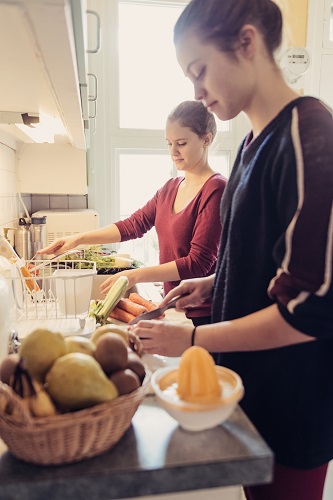19 Jan Eating well while flatting at University
Barriers to eating well while flatting at University can be overcome by planning and finding simple ways to make healthy eating a priority. Registered Dietitian Alison Pask offers some tips for those embarking on this stage of life.
Food choices are fundamental to achieve wellbeing, especially in young adults. Eating well needs to be a daily event where three meals, breakfast, lunch and dinner (plus snacks) impact on our wellbeing and where we can choose healthy options.

There may be numerous barriers to eating well, but don’t let these become excuses. You may have a busy lecture schedule, changes in routines, sports practice, lack of cooking skills, limited kitchen equipment or kitchen storage, be distant from a supermarket, no car, limited budget, food allergies, medical conditions, food likes and dislikes. Oh, and do not forget the odd party and social schedule!
However, healthy eating can work most of the time. To overcome the barriers planning is essential to make healthy eating a priority. This involves creating a shopping list and ensuring the right ingredients, equipment and time are available for the task.
Dinner together
A flat that cooks and eats together is a strong unit and this can provide great company and peer support. Knowing there is always dinner served at a set time adds routine and can be vital for good mental health. Sharing dinner is a great way for flatmates to provide support for one another and check in daily as well as receive nourishment.
Having a cooking roster as a flat has huge advantages but there may be valid reasons for cooking individually or in pairs too.
University flats vary in size and cooking can be successful for any number from one to twelve. Larger flats may need to break cooking into groups to be more successful.
Establishing a roster is the first step and there is not hard and fast rule around how this is done. It could be one person taking responsibility for “the works” with one night’s shopping, meal preparation, cooking, and cleaning. Cleaning your own dishes is a lot more fun than cleaning someone else’s cooking creations. It is a big task but only occurs once a week, resulting in the next few nights free of kitchen chores. Each flatmate only needs to know how to cook one recipe and can get away cooking the same meal every week. For those of us that have been flatting we all remember a flatmate who had mastered one recipe, usually spaghetti bolognaise!
Cooking together or in pairs is another option; that way you can learn from each other and build on each other’s strengths. Maybe one cooks and another does the dishes.
Cooking for yourself maybe a suitable solution; perhaps you have food allergies, a special diet or choose to eat different food from the other flatmates or simply love to cook. If cooking alone, sort out a place to store your food so flatmates do not dip into your supplies. You may allocate shelf space in the fridge or invest in your own small fridge in your room.
Investing in a flat freezer can be worthwhile so meals can be frozen in portions for another day. This can be valuable during periods of busy study or exams. You may find a friend you can swap a frozen meal with to increase the variety of meals. Cooking once and reheating the same meal again the next night is a wise option to reduce the time spent in the kitchen.

Ten Daily activities for good nutrition
- Have an adequate fluid intake. Tap water is the best as its free and readily available. It is easy to get dehydrated, especially in a new city where the temperature is different and there are so many new things to see and do. Drinking plenty of water will help those who like to party too.
- Start the day with breakfast and that could mean grabbing a piece of fruit as you walk out the door or try these breakfast ideas:
- Overnight bowl of oats, grated apple and yoghurt
- Instant porridge
- Breakfast cereal such as Weet-Bix with milk
- Add colour to your plate. The more colour, the more nutrition.
- Where possible choose wholegrain as it will keep you full for longer and is better for your gut health too e.g., wholegrain bread.
- Eat vegetables everyday:
- Buy vegetables in season. This concept may be new to young adults who are used to year-round availability.
- Locate a nearby fresh market where seasonal foods will be plentiful and of better value.
- Buy vegetables on special.
- Find alternatives to expensive vegetables. Only buy fresh tomatoes in the summer and find an alternative in winter such as canned tomatoes in cooked foods and sliced oranges in a salad.
- Canned or frozen vegetables are great choice. A can of tomatoes can be added to almost any meal. Frozen vegetables are quick and easy while still being nutritious.
- Store a jar of pickled vegetables in the fridge e.g. gherkins or olives, as these add variety and go a long way as you only need a few at a time for a pop of flavour.
- Include two fruit daily:
- Canned fruit in its own juice adds variety to breakfast cereal
- Fruit with yoghurt makes a great snack or quick lunch.
- Make the most of fresh fruit in season.
- Eat protein at each meal such as:
- Milk or yoghurt for breakfast or lunch
- Canned protein foods such as tuna, salmon, chicken are great for a quick sandwich filling or served on toast for a meal or snack. Choose fish canned in springwater rather than brine for a lower salt content.
- Eggs are easy and quick to cook and can be eaten for breakfast, lunch or dinner.
- Eat red meat up to three times a week. When buying aim for about 100 grams of raw meat per person. Buying the right amount will help with budgeting as meat is an expensive part of the meal.
- Nut butters can be used on toast or added to a stirfry vegetable dish to make a satay sauce.
- Make the most of legumes as they are economical sources of protein:
- Add drained canned chickpeas to almost any dish. They are delicious with roast vegetables for an extra crunch and flavour.
- A can of drained lentils added to mince bulks out the meal and often go unnoticed.
- Chilli beans added to mince give instant flavour and add lots of great fibre to the meal.
- A pot of soup in winter made with split peas is a cost-effective lunch.
- Use beans as the basis for homemade hummus and dips. These can be used to spread on sandwiches or toast.
- All cooked legumes can be added to salads or turned into delicious fritters or burger patties.
- Make eating a purposeful activity:
- Watching TV while eating dinner can increase the amount you eat. Switch off the TV, computer, games and cell phone while you’re eating dinner, so you aren’t distracted.
- Practicing good food hygiene is vital to stay well:
- Learn to store food correctly and if in doubt throw it out as you can’t afford to get food poisoning and miss lectures, project deadlines or exams.
- Wash dish cloths and tea towels regularly.
Three-step weekly checklist
- Plan the week ahead:
- Write a shopping list based on the meal plan agreed to
- Know what you are cooking and get prepared. You don’t want to be defrosting food at the last minute.
- Plan your grocery shopping. An online order and home delivery may be a great option for those without transport; it saves time and impulse buying too.
- Ensure snacks are easily accessible as this will avoid the temptation of buying expensive extras like hot chips or chocolate bars.
- Create structure:
- If you have a busy timetable one day, prepare your lunch the night before.
- Swap tasks with flatmates in advance if you have a busy week.
- Know your budget.
The University of Otago each year calculates weekly individual food costs and in 2019 a basic diet was estimated to cost $71 for a male and a female $60, with a few dollars more for an adolescent. The chances of consuming an inadequate diet increase as the amount spent to purchase food falls below the basic costs. See more details here.
Seven ways families can offer support:
- Teach your young adult to cook one meal from scratch.
- Start a collection of easy, cheap, and healthy recipes but don’t overload them with too many or too complicated options. Go for easy, quick, and inexpensive meals that can be made with limited equipment.
- Demonstrate good food hygiene.
- Share shortcuts such as your favorite packet of curry rather than providing a recipe for a curry made from scratch.
- Give practical Christmas gifts such as a slow cooker, a rice cooker or a toasted sandwich maker and teach your young adult how to use it.
- If your young person has a freezer, make suggestions on how to make the most of this such as preparing slow cooker meals ingredients and freezing meals ready to cook when needed.
- Send a supermarket delivery as a surprise treat. This could include:
- A wholegrain loaf of bread
- A block of cheese
- A packet of wraps
- Fresh fruit e.g. a bunch of bananas
- Raw mixed nuts
- A jar of peanut butter
- Send a new dish cloth, dish brush, goldilocks, and toothbrush as these are often not replaced.

